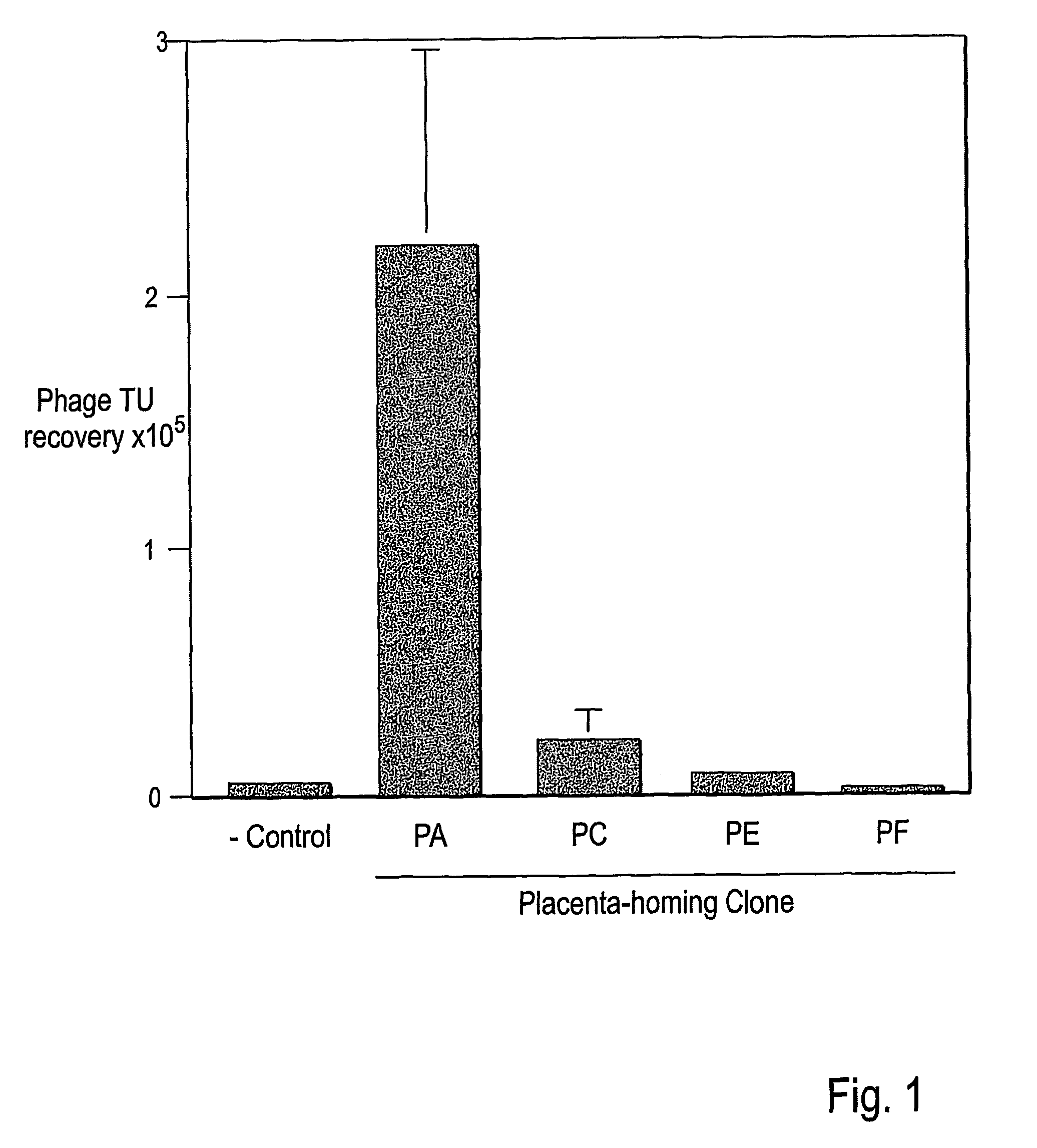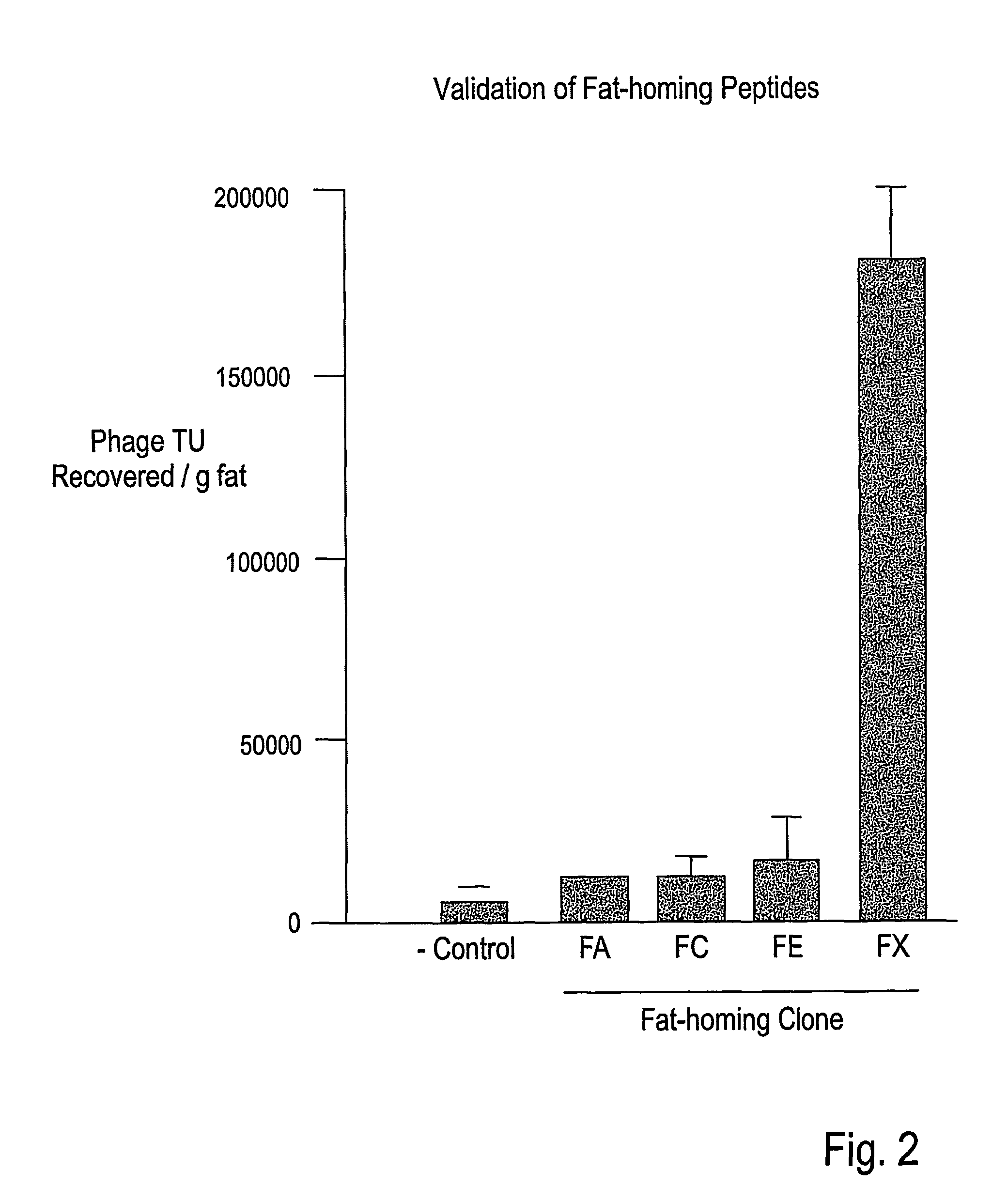Compositions and methods of use of targeting peptides against placenta and adipose tissues
a technology of targeting peptides and placenta, which is applied in the field of molecular medicine and targeted delivery of therapeutic agents, can solve the problems of long-term weight loss, fad diets that are only good for short-term weight loss, and cannot achieve long-term weight control
- Summary
- Abstract
- Description
- Claims
- Application Information
AI Technical Summary
Benefits of technology
Problems solved by technology
Method used
Image
Examples
example 1
Identification of Mouse Placenta Targeting Peptides
[0220]Identification of Placenta Homing Peptides
[0221]Peptides homing to the mouse placenta were identified by a post-clearing protocol using a phage display library. A first round of biopanning was performed on pregnant mice. Samples of placenta were removed and phage rescued according to protocols described below, with one modification. In the typical biopanning protocol, thousands of phage may be recovered from a single organ, tissue or cell type. Typically, between 200 and 300 individual colonies are selected from plated phage and these are amplified and pooled to form the phage display library for the second or third rounds of biopanning. In the present Example, all phage rescued from the first round of biopanning were amplified in bulk on solid medium and then pooled to form the phage display library for the second round of biopanning. That is, there was no restriction of the rescued phage from the first round of biopanning. T...
example 2
Localization of the TPKTSVT (SEQ ID NO:5) Peptide in Mouse Placenta
[0238]Material and Methods
[0239]Animals Staged pregnant 18 days postconception (dpc) C57BL / 6 female mice were purchased from Harlan Teklad (Indianapolis, Ind.). Congenic pregnant β2m-null females (stock 002087) mice were purchased from The Jackson Laboratories (Bar Harbor, Me.). Anesthesia was performed with Avertin (0.015 ml / g) administered intraperitoneally (Pasqualini and Ruoslahti, 1996, Nature 380:364-366; Rajotte et al., 1998, J. Clin. Invest. 102: 430437).
[0240]Phage Library Screening In vivo screening of an M13 page-display CX7C library (Pasqualini et al., 2000, in Phage Display: A Laboratory Manual, eds. Barbas et al., Cold Spring Harbor Laboratory Press, New York, N.Y., pp. 22.1-24; Arap et al., 2002, Nature Med. 8:121-127), for placenta-homing peptides was performed as described (Pasqualini et al., 2000; Pasqualini and Ruoslahti, 1996) with novel modifications described below. In each biopanning round, an ...
example 4
CKGGRAKDC (SEQ ID NO:22) Homes to White Fat in ob / ob Mice
[0267]Materials and Methods
[0268]Experimental Animals
[0269]C57BL / 6 mice were purchased from Harlan Teklad. Leptin-deficient (ob / ob) (stock 000632) and leptin receptor-deficient (stock 000642) mice were purchased from Jackson Laboratories (Bar Harbor, Me.). Anesthesia was performed with Avertin (0.015 ml / g) administered intraperitoneally (Arap, et al., 1998; Pasqualini & Rouslahti, 1996).
[0270]In vivo Phage Library Screening
[0271]In vivo phage-display screening of the CX7C library (C, cysteine; X, any amino acid) (Pasqualini et al., 2000; Arap et al., Nature Med. 8:121-127, 2002) for fat-homing peptides was performed (Pasqualini & Rouslahti 1996, Pasqualini et al., 2000). In each biopanning round, an adult ob / ob mouse was injected intravenously (tail vein) with 1010 transducing units (TU) of the library. Phage (˜300 TU / g in round 1 increased to ˜104 TU / g in round 3) were recovered after 5 min of circulation by grinding subcutan...
PUM
| Property | Measurement | Unit |
|---|---|---|
| temperature | aaaaa | aaaaa |
| ionic strength | aaaaa | aaaaa |
| weight | aaaaa | aaaaa |
Abstract
Description
Claims
Application Information
 Login to View More
Login to View More - R&D
- Intellectual Property
- Life Sciences
- Materials
- Tech Scout
- Unparalleled Data Quality
- Higher Quality Content
- 60% Fewer Hallucinations
Browse by: Latest US Patents, China's latest patents, Technical Efficacy Thesaurus, Application Domain, Technology Topic, Popular Technical Reports.
© 2025 PatSnap. All rights reserved.Legal|Privacy policy|Modern Slavery Act Transparency Statement|Sitemap|About US| Contact US: help@patsnap.com



